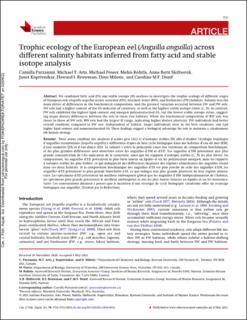Trophic ecology of the european eel (Anguilla anguilla) across different salinity habitats inferred from fatty acid and stable isotope analysis
| dc.contributor.author | Parzanini, Camilla | |
| dc.contributor.author | Arts, Michael T. | |
| dc.contributor.author | Power, Michael | |
| dc.contributor.author | Rohtla, Mehis | |
| dc.contributor.author | Skiftesvik, Anne Berit | |
| dc.contributor.author | Koprivnikar, Janet | |
| dc.contributor.author | Browman, Howard | |
| dc.contributor.author | Milotic, Dino | |
| dc.contributor.author | Durif, Caroline | |
| dc.date.accessioned | 2022-02-10T08:55:44Z | |
| dc.date.available | 2022-02-10T08:55:44Z | |
| dc.date.created | 2022-02-05T15:36:57Z | |
| dc.date.issued | 2021 | |
| dc.identifier.citation | Canadian Journal of Fisheries and Aquatic Sciences. 2021, 78 (11), 1721-1731. | en_US |
| dc.identifier.issn | 0706-652X | |
| dc.identifier.uri | https://hdl.handle.net/11250/2978157 | |
| dc.description.abstract | We combined fatty acid (FA) and stable isotope (SI) analyses to investigate the trophic ecology of different stages of European eels (Anguilla anguilla) across seawater (SW), brackish water (BW), and freshwater (FW) habitats. Salinity was the main driver of differences in the biochemical composition, and the greatest variation occurred between SW and FW eels. SW eels had a higher content of the FA indicator of carnivory, as well as the highest stable isotope ratios (C, N). In contrast, FW eels exhibited the highest lipid content and omega-6 polyunsaturated FA, but the lowest stable isotope ratios, suggesting major dietary differences between the eels in these two habitats. While the biochemical composition of BW eels was closer to those of SW eels, BW eels had the largest SI range, indicating higher dietary plasticity. FW individuals had better overall condition compared to SW eels. Independent of habitat, larger individuals were in the best condition, and had higher lipid content and monounsaturated FA. These findings suggest a biological advantage for eels to maintain a catadromous life history strategy. | en_US |
| dc.language.iso | eng | en_US |
| dc.title | Trophic ecology of the european eel (Anguilla anguilla) across different salinity habitats inferred from fatty acid and stable isotope analysis | en_US |
| dc.type | Peer reviewed | en_US |
| dc.type | Journal article | en_US |
| dc.description.version | publishedVersion | en_US |
| dc.source.pagenumber | 1721-1731 | en_US |
| dc.source.volume | 78 | en_US |
| dc.source.journal | Canadian Journal of Fisheries and Aquatic Sciences | en_US |
| dc.source.issue | 11 | en_US |
| dc.identifier.doi | 10.1139/cjfas-2020-0432 | |
| dc.identifier.cristin | 1998100 | |
| dc.relation.project | Norges forskningsråd: 280658 | en_US |
| cristin.ispublished | true | |
| cristin.fulltext | original | |
| cristin.qualitycode | 2 |
Tilhørende fil(er)
Denne innførselen finnes i følgende samling(er)
-
Articles [3011]
-
Publikasjoner fra CRIStin [3061]
